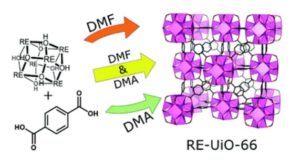We are delighted to introduce Ashlee Howarth, our latest #ChemComm1st author. Ashlee’s first independent research article was published in ChemComm in May. Her Communication ‘Synthetic approaches for accessing rare-earth analogues of UiO-66‘ has now been added to our growing collection, ChemComm Milestones – First Independent Articles. Find out more about Ashlee in our interview with her below.
Our ChemComm Milestones interview with Ashlee Howarth
What are the main areas of research in your lab and what motivated you to take this direction?
In my research lab at Concordia, we are interested in the design and synthesis of new rare-earth metal–organic frameworks comprised of multinuclear cluster nodes. We take inspiration from the field of zirconium-based MOFs – materials that I worked with extensively during my postdoctoral studies – where the vast majority of Zr-MOFs contain hexanuclear cluster nodes as building blocks. We are interested in using rare-earth metals to construct MOFs because of the possibility to generate several multinuclear rare-earth clusters (e.g., tetranuclear, hexanuclear, nonanuclear, etc) with varying geometry and connectivity. The diversity of cluster building blocks that are accessible, allows us to synthesize structures that are not as easily attainable (or not attainable at all) using other metals. We are still in the early stages of this research, but our long-term goals are to study these materials for the adsorption, catalytic breakdown, and chemical sensing of hazardous analytes.
Can you set this article in a wider context?
UiO-66 is a zirconium-based MOF that was first reported by researchers from the University of Oslo in 2008 (https://doi.org/10.1021/ja8057953). Since this initial report, there have been over 4,000 publications on the topic of UiO-66. This is because it is a highly robust MOF, built from hexanuclear zirconium clusters bridged by simple terephthalic acid linkers, and has been shown to be potentially useful for applications ranging from gas capture to catalysis to drug delivery. In this article, we report on the synthesis and characterization of eight rare-earth analogues of UiO-66, specifically the Y(III), Eu(III), Gd(III), Tb(III), Ho(III), Er(III), Tm(III), and Yb(III) analogue. We hope to see these rare-earth analogues of UiO-66 become extensively studied over the next decade, just like the Zr-based prototype.
What do you hope your lab can achieve in the coming year?
In the upcoming year, I hope that we can continue to build foundational knowledge with regards to the tips and tricks for synthesizing rare-earth cluster-based MOFs. This includes expanding on knowledge of de novo as well as post-synthetic modification techniques, purification and activation strategies, and methods for characterizing the chemical and physical properties of these new materials.
Describe your journey to becoming an independent researcher.
My journey to becoming an independent researcher began when I completed an Honours specialization project as an undergraduate student in the Corrigan lab at the University of Western Ontario. This was when I first learned about research, the possibility of graduate school, and the steps required to become an independent researcher in academia. From there my love for research, and specifically inorganic materials chemistry, continued to grow as a PhD student in the Wolf lab at the University of British Columbia. I was first introduced to MOFs during my postdoctoral studies in the Farha and Hupp groups at Northwestern University, and it was during my 3 years as a postdoc that I grew to love these materials. I was (and continue to be) fascinated by the fundamental aspects of MOF chemistry, discovering new building blocks, making new network structures, and growing crystals. I also love that MOFs have many potential practical applications due to their high porosities, surface areas, and tunable properties. As such, when finishing my postdoctoral studies I knew I wanted to continue working with MOFs – but I wanted to branch out from working with Zr-MOFs and start exploring the use of rare-earth elements. It’s been quite challenging working on a subclass of MOFs that are entirely new to me, but it’s also been very rewarding, and my students and I learn something new every day.
What is the best piece of advice you have ever been given?
It’s quite hard to choose just one piece of advice, since I have been given lots of great advice from my mentors over the years. One piece of advice that has always stuck with me, which came from my undergraduate supervisor John F. Corrigan, is to always be yourself. It sounds simple enough, but I was giving a practice presentation for my honours thesis defense and I had made pink PowerPoint slides. One of the other students in the group suggested I change the colour since pink might not be the most obvious choice for a professional scientific presentation. John told me to leave the colour if I liked it, and to always be myself. I’ve carried that advice with me throughout my scientific career and it has helped to give me confidence in myself as a scientist – even at times when I don’t always feel like I belong.
Why did you choose to publish in ChemComm?
ChemComm is a great journal with an excellent reputation in chemistry. I always wanted to publish in ChemComm when I was a graduate student but never had the opportunity. When my student, Pedro Donnarumma, was able to find the synthetic conditions necessary to make the first ever rare-earth analogues of UiO-66, I thought that ChemComm would be the perfect venue to disseminate the results quickly and have high visibility within the MOF and materials chemistry communities. I’m very proud to say that my first publication as an independent researcher is in ChemComm and I’m especially proud of the students Pedro Donnarumma (lead author, MSc graduate), Sahara Frojmovic (undergraduate Honours student), Paola Marino (MSc Student), and Hudson Bicalho (PhD candidate) who worked so hard to make it possible! The work also wouldn’t be possible without our awesome collaborator and expert crystallographer Dr. Hatem Titi.
Explore more ChemComm Milestones news and updates on our Twitter: @ChemCommun












